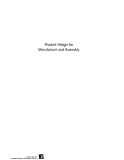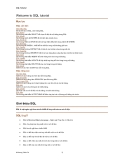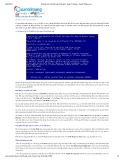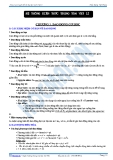Product Design for Manufacture and Assembly
ISBN: 0-8247-0584-X
This book is printed on acid-free paper.
Headquarters Marcel Dekker, Inc. 270 Madison Avenue, New York, NY 10016 tel: 212-696-9000; fax: 212-685-4540
Eastern Hemisphere Distribution Marcel Dekker AG Hutgasse 4, Postfach 812, CH-4001 Basel, Switzerland tel: 41-61-261-8482; fax: 41-61-261-8896
World Wide Web http: //www.dekker. com
The publisher offers discounts on this book when ordered in bulk quantities. For more information, write to Special Sales/Professional Marketing at the headquarters address above.
Copyright © 2002 by Marcel Dekker, Inc. All Rights Reserved.
Neither this book nor any part may be reproduced or transmitted in any form or by any means, electronic or mechanical, including photocopying, microfilming, and recording, or by any information storage and retrieval system, without permission in writing from the publisher.
Current printing (last digit): 10 9 8 7 6 5 4 3 21
PRINTED IN THE UNITED STATES OF AMERICA
MANUFACTURING ENGINEERING AND MATERIALS PROCESSING A Series of Reference Books and Textbooks
EDITOR
loan Marinescu University of Toledo Toledo, Ohio
FOUNDING EDITOR
Geoffrey Boothroyd Boothroyd Dewhurst, I m Wa kefield, RIi ode Island
1. Computers in Manufacturing, U. Rembold, M. Seth, and J. S. Weinstein 2. Cold Rolling of Steel, William L. Roberts 3. Strengthening of Ceramics: Treatments, Tests, and Design Applications,
Harry P. Kirchner
4. Metal Forming: The Application of Limit Analysis, Betzalel Avitzur 5. Improving Productivity by Classification, Coding, and Data Base Standard- ization: The Key to Maximizing CAD/CAM and Group Technology, William F. Hyde
6. Automatic Assembly, Geoffrey Boothroyd, Corrado Poli, and Laurence E.
Murch
7. Manufacturing Engineering Processes, Leo Alting 8. Modern Ceramic Engineering: Properties, Processing, and Use in Design,
David W. Richerson
9. Interface Technology for Computer-Controlled Manufacturing Processes,
Ulrich Rembold, Karl Armbruster, and Wolfgang Ulzmann
10. Hot Rolling of Steel, William L. Roberts 11. Adhesives in Manufacturing, edited by Gerald L. Schneberger 12. Understanding the Manufacturing Process: Key to Successful CAD/CAM
I m pl eme n ta tio n , Joseph Ha rrington , Jr.
13. Industrial Materials Science and Engineering, edited by Lawrence E. Murr 14. Lubricants and Lubrication in Metalworking Operations, Elliot S. Nachtman
and Serope Kalpakjian
15. Manufacturing Engineering: An Introduction to the Basic Functions, John P.
Tanner
16. Computer-Integrated Manufacturing Technology and Systems, Ulrich
Rembold, Christian Blume, and Ruediger Dillman
17. Connections in Electronic Assemblies, Anthony J. Bilotta 18. Automation for Press Feed Operations: Applications and Economics,
Edward Walker
19. Nontraditional Manufacturing Processes, Gary F. Benedict 20. Programmable Controllers for Factory Automation, David G. Johnson 21. Printed Circuit Assembly Manufacturing, Fred W. Kear
22. Manufacturing High Technology Handbook, edited by Donatas Tuunelis and
Keith E. McKee
23. Factory Information Systems: Design and Implementation for CIM Manage-
ment and Control, John Gaylord
24. Flat Processing of Steel, William L. Roberts
26. Flexible Manufacturing Systems in Practice: Applications, Design, and
Simulation, Joseph Talavage and Roger G. Hannam
27. Flexible Manufacturing Systems: Benefits for the Low Inventory Factory,
John E. Lenz
28. Fundamentals of Machining and Machine Tools: Second Edition, Geoffrey
Boothroyd and Winston A. Knight
29. Computer-Automated Process Planning for World-Class Manufacturing,
James Nolen
30. Steel-Rolling Technology: Theory and Practice, Vladimir B. Ginzburg 31. Computer Integrated Electronics Manufacturing and Testing, Jack Arabian 32. In-Process Measurement and Control, Stephan D. Murphy 33. Assembly Line Design: Methodology and Applications, We-Min Chow 34. Robot Technology and Applications, edited by Ulrich Rembold 35. Mechanical Deburring and Surface Finishing Technology, Alfred F. Scheider 36. Manufacturing Engineering: An Introduction to the Basic Functions, Second
Edition, Revised and Expanded, John P. Tanner
37. Assembly Automation and Product Design, Geoffrey Boothroyd 38. Hybrid Assemblies and Multichip Modules, Fred W. Kear 39. High-Quality Steel Rolling: Theory and Practice, Vladimir B. Ginzburg 40. Manufacturing Engineering Processes: Second Edition, Revised and Ex-
panded, Leo Alting
41. Metalworking Fluids, edited by Jerry P. Byers 42. Coordinate Measuring Machines and Systems, edited by John A. Bosch 43. Arc Welding Automation, Howard B. Cary 44. Facilities Planning and Materials Handling: Methods and Requirements,
Vbay S. Sheth
45. Continuous Flow Manufacturing: Quality in Design and Processes, Pierre C.
Guerindon
46. Laser Materials Processing, edited by Leonard Migliore 47. Re-Engineering the Manufacturing System: Applying the Theory of Con-
straints, Robert €. Stein
48. Handbook of Manufacturing Engineering, edited by Jack M. Walker 49. Metal Cutting Theory and Practice, David A. Stephenson and John S.
Agapiou
50. Manufacturing Process Design and Optimization, Robert F. Rhyder 51. Statistical Process Control in Manufacturing Practice, Fred W. Kear 52. Measurement of Geometric Tolerances in Manufacturing, James D. Mea-
dows
53. Machining of Ceramics and Composites, edited by Said Jahanmir, M. Rarnulu,
and Philip Koshy
54. Introduction to Manufacturing Processes and Materials, Robert C. Creese 55. Computer-Aided Fixture Design, Yiming (Kevin) Rong and Yaoxiang
(Stephens) Zhu
56. Understanding and Applying Machine Vision: Second Edition, Revised and
Expanded, Nello Zuech
57. Flat Rolling Fundamentals, Vladimir B. Ginzburg and Robert Ballas
58. Product Design for Manufacture and Assembly: Second Edition, Revised and
Expanded, Geoffrey Boothroyd, Peter Dewhurst, and Winston Knight
Additional Volumes in Preparation
Preface to the Second Edition
This second edition of Product Design for Manufacture and Assembly includes three new chapters, describing the processes of sand casting, investment casting, and hot forging. These chapters, combined with the chapters describing design for machining, injection molding, sheet metalworking, die casting, and powder metals, cover a wide range of the most basic forming processes used in industry. In addition, substantial material has been added to the introductory chapter illustrating the effects that the application of design for manufacture and assembly (DFMA) has had on U.S. industry as a whole. Chapter 2, dealing with the selection of materials and processes for manufacture, now includes further material describing material selection specifically and the economic ranking of processes using a new software tool.
Chapter 3, dealing with product design for manual assembly, includes an updated special section dealing with the effect of design on product quality. Finally, additional material has been added to Chapter 15 discussing links between computer-aided design (CAD) solid models and design analysis tools. As with the previous edition, we thank the various companies who have supported research on DFMA at the University of Rhode Island and the graduate students who have contributed to the research. We particularly acknowledge the help of Allyn Mackay, on whose work the new chapter on investment casting is largely based.
Geoffrey Boothroyd Peter Dewhurst Winston Knight
\\\
Finally, thanks are due to Shirley Boothroyd for typing much of the new material and to Kenneth Fournier for preparing some of the additional artwork.
Preface to the First Edition
We have been working in the area of product design for manufacture and assembly (DFMA) for over twenty years. The methods that have been developed have found wide application in industry—particularly U.S. industry. In fact, it can be said that the availability of these methods has created a revolution in the product design business and has helped to break down the barriers between design and manufacture; it has also allowed the development of concurrent or simultaneous engineering.
provides the details of DFMA methods for practicing and student engineers.
Much of the methodology involves analytical tools that allow designers and manufacturing engineers to estimate the manufacturing and assembly costs of a proposed product before detailed design has taken place. Unlike other texts on the subject, which are generally descriptive, this text provides the basic equations and data that allow manufacturing and assembly cost estimates to be made. Thus, for a limited range of materials and processes the engineer or student can make cost estimates for real parts and assemblies and, therefore, become familiar with the details of the methods employed and the assumptions made.
This book not only summarizes much of our work on DFMA, but also
For engineering students, this book is suitable as a text on product design for manufacture and assembly and, in fact, is partially based on notes for a two- course sequence developed by the authors at the University of Rhode Island.
For practicing manufacturing engineers and designers, this book is not meant as a replacement for the DFMA software developed by Boothroyd Dewhurst, Inc., which contains more elaborate databases and algorithms, but rather provides a useful companion, allowing an understanding of the methods involved.
vi
Preface to the First Edition
The original work on design for assembly was funded at the University of Massachusetts by the National Science Foundation. Professor K. G. Swift and Dr. A. H. Redford of the Universities of Hull and Salford, respectively, collaborated with G. Boothroyd in this early work and were supported by the British Science Research Council.
The research continued at the University of Rhode Island and was supported mainly by U.S. industry. We thank the following companies for their past and, in some cases, continuing support of the work: Allied, AMP, Digital Equipment, DuPont, EDS, Ford, General Electric, General Motors, Gillette, IBM, Instron, Loctite, Motorola, Navistar, Westinghouse, and Xerox.
We also thank all the graduate assistants and research scholars who over the years have contributed to the research, including: N. Abbatiello, A. Abbot, A. Anderson, J. Anderson, T. Andes, D. Archer, G. Bakker, T. Becker, C. Blum, T. Bassinger, K. P. Brindamour, R. C. Burlingame, T. Bushman, J. P. Cafone, A. Carnevale, M. Caulfield, H. Connelly, T. J. Consunji, C. Donovan, J. R. Donovan, W A. Dvorak, C. Elko, B. Ellison, M. C. Fairfield, J. Farris, T. J. Feenstra, M. B. Fein, R. P. Field, T. Fujita, A. Fumo, A. Girard, T. S. Hammer, P. Hardro, Y. S. Ho, L. Ho, L. S. Hu, G. D. Jackson, J. John II, B. Johnson, G. Johnson, K. Ketelsleger, G. Kobrak, D. Kuppurajan, A. Lee, C. C. Lennartz, H. C. Ma, D. Marlowe, S. Naviroj, N. S. Ong, C. A. Porter, P. Radovanovic, S. C. Ramamurthy, B. Rapoza, B. Raucent, M. Roe, L. Rosario, M. Schladenhauffen, B. Seth, C. Shea, T. Shinohara, J. Singh, R. Stanton, M. Stanziano, G. Stevens, A. Subramani, B. Sullivan, J. H. Timmins, E. Trolio, R. Turner, S. C. Yang, Z. Yoosufani, J. Young, J. C. Woschenko, D. Zenger, and Y. Zhang.
We would also like to thank our colleagues, the late Professor C. Reynolds, who collaborated in the area of early cost estimating for manufactured parts, and Professor G. A. Russell, who collaborated in the area of printed circuit board assembly.
Geoffrey Boothroyd Peter Dewhurst Winston Knight
Finally, thanks are due to Kenneth Fournier for preparing much of the artwork.
Contents
Preface to the Second Edition Preface to the First Edition
Hi v
1.
1 1 8 16 Introduction 1.1 What Is Design for Manufacture and Assembly? 1.2 How Does DFMA Work? 1.3 Reasons for Not Implementing DFMA 1.4 What Are the Advantages of Applying DFMA During
1.5 1.6 Overall Impact of DFMA on U.S. Industry 1.7 Conclusions
References
Product Design? Typical DFMA Case Studies
2. Selection of Materials and Processes
21 22 34 39 40
43 43
2.3 2.4 2.5 2.6 2.7
Selection Selection of Manufacturing Processes Process Capabilities Selection of Materials Primary Process/Material Selection Systematic Selection of Processes and Materials References
45 46 48 55 65 71 83
Introduction 2.1 2.2 General Requirements for Early Materials and Process
vii
viii
Contents
3. Product Design for Manual Assembly
Introduction
Classification Systems Effect of Part Symmetry on Handling Time Effect of Part Thickness and Size on Handling Time Effect of Weight on Handling Time Parts Requiring Two Hands for Manipulation
85 85 86 93 93 96 96 101 103 104 104
3.1 3.2 General Design Guidelines for Manual Assembly 3.3 Development of the Systematic DFA Methodology 3.4 Assembly Efficiency 3.5 3.6 3.7 3.8 3.9 3.10 Effects of Combinations of Factors 3.11 Effect of Symmetry for Parts that Severely Nest or Tangle and May Require Tweezers for Grasping and Manipulation
104 105 108 109 111
3.12 Effect of Chamfer Design on Insertion Operations 3.13 Estimation of Insertion Time 3.14 Avoiding Jams During Assembly 3.15 Reducing Disc-Assembly Problems 3.16 Effects of Obstructed Access and Restricted Vision on
Insertion of Threaded Fasteners of Various Designs
112
3.17 Effects of Obstructed Access and Restricted Vision on
Pop-Riveting Operations 3.18 Effects of Holding Down 3.19 Manual Assembly Database and Design Data Sheets 3.20 Application of the DFA Methodology 3.21 Further Design Guidelines 3.22 Large Assemblies 3.23 Types of Manual Assembly Methods 3.24 Effect of Assembly Layout on Acquisition Times 3.25 Assembly Quality 3.26 Applying Learning Curves to the DFA Times
References
115 115 118 119 125 128 130 133 137 141 143
4. Electrical Connections and Wire Harness Assembly
Introduction
Types of Electrical Connections Types of Wires and Cables Preparation and Assembly Times
4.1 4.2 Wire or Cable Harness Assembly 4.3 4.4 4.5 4.6 Analysis Method References
147 147 149 152 159 160 182 190
Contents
ix
5. Design for High-Speed Automatic Assembly and Robot Assembly
Example
Example
191 191 192 196 199 199 201 202 203 208
Introduction
Assembly
5.11 Product Design for Robot Assembly
References
210 211 217
6. Printed Circuit Board Design for Manufacture and Assembly
5.1 5.2 Design of Parts for High-Speed Feeding and Orienting 5.3 5.4 Additional Feeding Difficulties 5.5 High-Speed Automatic Insertion 5.6 5.7 Analysis of an Assembly 5.8 General Rules for Product Design for Automation 5.9 Design of Parts for Feeding and Orienting 5.10 Summary of Design Rules for High-Speed Automatic
Introduction
Types of Printed Circuit Boards Terminology
219 219 220 220 222 223 238 244 249 252 263 266
6.1 6.2 Design Sequence for Printed Circuit Boards 6.3 6.4 6.5 Assembly of Printed Circuit Boards 6.6 Estimation of PCB Assembly Costs 6.7 Case Studies in PCB Assembly PCB Manufacturability 6.8 6.9 Design Considerations 6.10 Glossary of Terms References
Standardization
7. Design for Machining Introduction
References
7.1 7.2 Machining Using Single-Point Cutting Tools 7.3 Machining Using Multipoint Tools 7.4 Machining Using Abrasive Wheels 7.5 7.6 Choice of Work Material 7.7 Shape of Work Material 7.8 Machining Basic Component Shapes 7.9 Assembly of Components 7.10 Accuracy and Surface Finish 7.11 Summary of Design Guidelines 7.12 Cost Estimating for Machined Components 267 267 267 275 284 290 291 293 294 307 308 311 313 337
Contents
Insert Molding
References
9. Design for Sheet Metalworking Introduction
Press Selection Turret Pressworking Press Brake Operations
8. Design for Injection Molding Introduction 8.1 Injection Molding Materials 8.2 The Molding Cycle 8.3 Injection Molding Systems 8.4 Injection Molds 8.5 8.6 Molding Machine Size 8.7 Molding Cycle Time 8.8 Mold Cost Estimation 8.9 Mold Cost Point System 8.10 Estimation of the Optimum Number of Cavities 8.11 Design Example 8.12 8.13 Design Guidelines 8.14 Assembly Techniques 339 339 340 342 344 346 351 353 359 367 369 372 374 375 376 379
References
381 381 383 403 409 413 416 422
9.1 9.2 Dedicated Dies and Press-working 9.3 9.4 9.5 9.6 Design Rules
10. Design for Die Casting
Introduction 10.1 10.2 Die Casting Alloys 10.3 The Die Casting Cycle 10.4 Die Casting Machines 10.5 Die Casting Dies 10.6 Finishing 10.7 Auxiliary Equipment for Automation 10.8 Determination of the Optimum Number of Cavities 10.9 Determination of Appropriate Machine Size 10.10 Die Casting Cycle Time Estimation 10.11 Die Cost Estimation 10.12 Assembly Techniques 10.13 Design Principles References 423 423 423 425 426 429 430 432 433 439 443 453 457 458 459
Contents
xi
11. Design for Powder Metal Processing
461 461 463 464 468 475 478 481 484 489
Introduction
Costs
492 511
11.11 Modifications for Infiltrated Materials 11.12
11.1 11.2 Main Stages in the Powder Metallurgy Process 11.3 Secondary Manufacturing Stages 11.4 Compaction Characteristics of Powders Tooling for Powder Compaction 11.5 Presses for Powder Compaction 11.6 Form of Powder Metal Parts 11.7 11.8 Sintering Equipment Characteristics 11.9 Materials for Powder Metal Processing 11.10 Contributions to Basic Powder Metallurgy Manufacturing
11.13 Some Design Guidelines for Powder Metal Parts
References
512 514 515
Impregnation, Heat Treatment, Tumbling, Steam Treatment, and Other Surface Treatments
12. Design for Sand Casting
Sand Cores
Introduction Sand Casting Alloys
12.1 12.2 12.3 Basic Characteristics and Mold Preparation 12.4 12.5 Melting and Pouring of Metal 12.6 Cleaning of Castings 12.7 Cost Estimating 12.8 Design Rules for Sand Castings Example Calculations 12.9 References 517 517 519 519 524 525 526 527 537 542 546
13. Design for Investment Casting
Introduction Process Overview Pattern Materials Pattern Injection Machines Pattern Molds Pattern and Cluster Assembly The Ceramic Shell-Mold
13.1 13.2 13.3 13.4 13.5 13.6 13.7 13.8 Ceramic Cores 13.9 Pattern Meltout 13.10 Pattern Burnout and Mold Firing 13.11 Knockout and Cleaning 549 549 549 552 552 554 554 555 556 556 557 557
xii
Contents
Investing the Pattern Cluster
13.12 Cutoff and Finishing 13.13 Pattern and Core Material Cost 13.14 Wax Pattern Injection Cost 13.15 Fill Time 13.16 Cooling Time 13.17 Ejection and Reset Time 13.18 Process Cost per Pattern or Core 13.19 Estimating Core Injection Cost 13.20 Pattern and Core Mold Cost 13.21 Core Mold Cost 13.22 Pattern and Cluster Assembly Cost 13.23 Number of Parts per Cluster 13.24 Pattern Piece Cost 13.25 Cleaning and Etching 13.26 Shell Mold Material Cost 13.27 13.28 Pattern Meltout 13.29 Burnout, Sinter, and Preheat 13.30 Total Shell Mold Cost 13.31 Cost to Melt Metal 13.32 Raw Base Metal Cost 13.33 Ready-to-Pour Liquid Metal Cost 13.34 Pouring Cost 13.35 Final Material Cost 13.36 Breakout 13.37 Cleaning 13.38 Cutoff 13.39 Design Guidelines References 557 557 561 562 562 564 566 567 567 572 572 574 575 576 576 577 578 578 579 579 583 584 584 584 586 587 587 590 591
14. Design for Hot Forging Introduction
14.1 14.2 Characteristics of the Forging Process The Role of Flash in Forging 14.3 Forging Allowances 14.4 Preforming During Forging 14.5 14.6 Flash Removal 14.7 Classification of Forgings 14.8 Forging Equipment 14.9 Classification of Materials 14.10 Forging Costs 14.11 Forging Die Costs 593 593 593 595 600 603 609 610 613 622 622 631
Contents
xiii
14.12 Die Life and Tool Replacement Costs 14.13 Costs of Flash Removal 14.14 Other Forging Costs References
636 637 640 641
15. Design for Manufacture and Computer-Aided Design
643 643
Analysis
15.3 Geometric Representation Schemes in CAD Systems 15.4 Design Process in a Linked CAD/DFMA Environment Extraction of DFMA Data from CAD System Database 15.5 Expert Design and Cost Estimating Procedures 15.6 References
643 645 660 663 665 668
Nomenclature Index
669 683
Introduction 15.1 15.2 General Considerations for Linking CAD and DFMA

























